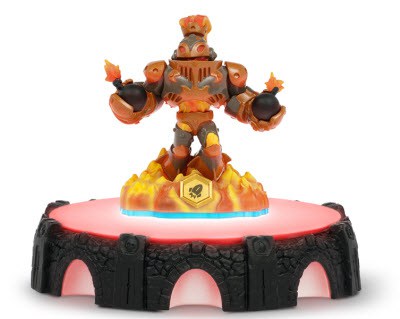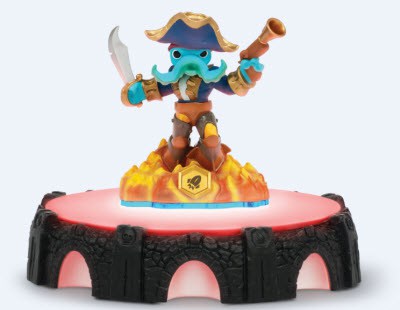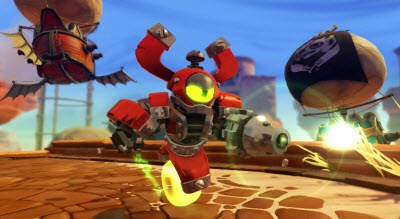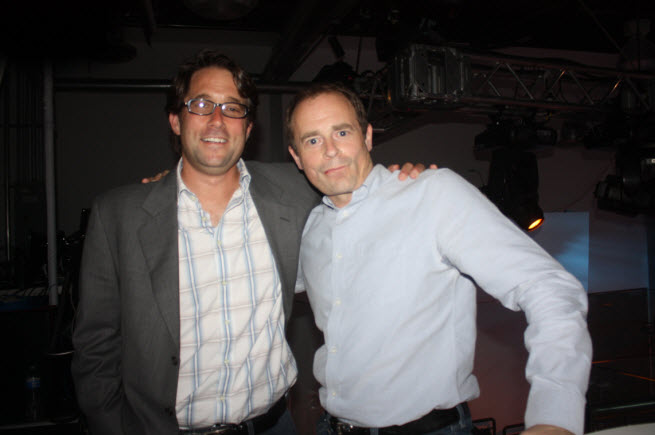Skylanders: Swap Force will debut this fall as the third in the series of game-toy hybrid products that have sold more than $1 billion worth since 2011. The new game has interchangeable body halves of Skylanders: Swap Force toys, allowing kids to mix and match their collections to create new kinds of game characters. Activision hopes that will lead to more repeat business at a time when it will face significant competition from Disney’s upcoming Infinity toy-game hybrid products launching in August.
In this market, Activision is the smaller company, but it has the advantage of having sold more than 115 million Skylanders toys.
The challenge for Activision’s marketer’s — Josh Taub (left) senior vice president of product management, and John Coyne (right), senior vice president of consumer marketing — will be to grow the franchise at a time when Disney attacks the same market using famous entertainment brands such as Toy Story, The Incredibles, Monsters Inc. (and the upcoming Monsters University), and Cars. Activision Blizzard chief executive Bobby Kotick said in a recent earnings call that the company will face significant competition in the second half of the year, making financial performance less predictable. Activision is going to spend more money marketing its titles later this year, and that means there’s going to be a lot more pressure on Taub and Coyne to execute.
Here’s the edited transcript of our interview with Taub and Coyne.
 GamesBeat: You’ve built up something pretty big in a couple of years here.
GamesBeat: You’ve built up something pretty big in a couple of years here.
Coyne: Yep. We’re very proud of the growth that we’ve seen for Skylanders in about 18 months. We’re now over a billion dollars. For myself, I’ve been involved with the franchise now for more than four years. It’s been a great project, seeing everything come to fruition.
GamesBeat: You have competition coming from Disney Infinity. What does that mean for you?
Taub: It means that we have to continue to focus on where we started and where we’re going. We’ve innovated a category, bringing toys to life. We’re focused on what we’re doing. We’ve sold more than 115 million toys to date. We have kids playing on nine-million-plus starter packs. We’re focused on providing them with an innovative experience in the franchise, and we’re focused on doing what we do best, which is bringing a great video game experience and a great toy experience together.
GamesBeat: Obviously you have a really good margin for add-on sales after the base pack, especially with your great relationship with retail. The setups in Toys R Us are amazing. But there are 60 new toys coming out this season. That’s a significant amount of product. Is there a point where you worry that you’re going to get pushback from consumers when it comes to the number of toys being released?
Taub: I think what’s happened is that the consumers are actually telling us that they have an appetite for things that feel special to them, and the ways of interacting that are unique to the game. What they’re doing through buying the toys is having different engagements with the franchise as a whole. We’re not seeing at it as “there’s a saturation point.” We’re seeing it as there’s place where kids want to continue to come back through the year, and rather than buying the next game, they’re buying what is in a sense add-on content to experience the same game in a different way. Each time they put a new character on and have a different weapon or a different play pattern, it gives them a unique experience that they’re not getting anywhere else. We’re not seeing saturation as an issue. In fact, our attach rates are up from the first game to the second. We anticipate that will continue.
GamesBeat: Can you give us any specifics on what those attach rates are?
Taub: At this time, we can’t.
GamesBeat: Has the demographic shifted any since launch? It does seem like, just anecdotally, as it’s become a bigger deal, more people have come in from a broader audience saying, “This isn’t just a game for my eight-year-old.”
Coyne: I think there is a core still, but I do think it’s something that gamers are enjoying — the toys coming to life, the characters. Families enjoy it. Girls as well as boys enjoy the game. It really is quite a broad demographic that we’re seeing enjoy the game. I hope that, with the new game, we’ll see that trend continue.
 GamesBeat: What about the spread between the people who buy a few and the people who have to collect ‘em all?
GamesBeat: What about the spread between the people who buy a few and the people who have to collect ‘em all?
Coyne: I’ve worked on a lot of toy franchises, collectible franchises. You’re always going to have people that choose very carefully the characters they buy, and then you’re going to have some kids and gamers who want to get everything that they can. The game is equally enjoyable either way. We always make sure that you can play through the game with the starter pack toys.
Taub: The last piece on the expanding demographic is that they’re seeing that we’re not setting out to make a game that is just a kids’ game. It’s a triple-A game in every way, from graphical fidelity to development time to the studios that are involved. It’s a meaningful gaming experience. While kids may be the place where it started, you’re starting to see an appreciation for the quality of gameplay and the replayability and the enjoyment factor.
Coyne: That’s also true when you see families play together. It’s the type of game where dads and moms enjoy playing with their sons and daughters. It’s an easy game to enjoy.
GamesBeat: There’s been a significant amount of product released in the last 18 months across different platforms, different SKUs. What have you learned in this process about being, essentially, a toy company? Have there been changes in how you approach that side of the business?
Coyne: My background is in toy companies, so it’s not necessarily something new to me. Activision as a company, we’ve learned lots of things. The genre is very interesting. Where physical meets digital is incredibly compelling to kids. As Josh said, and as Eric said on the stage, the key is innovation and the magic. That’s what keeps fans engaged, and as long as we keep delivering that innovation and that magic, we’re going to continue to see the success that we’ve seen.
GamesBeat: Guitar Hero was another kind of hybrid toy-game, but it eventually hit a saturation point. I wonder if you have any lessons from that.
Taub: It’s a different piece. The music genre was a mechanism of play and a play pattern. Mixing that play pattern up over time was challenging. If there are innovations against that, there’s an opportunity for that to thrive again at some point. But this is something that has gaming at its core. The people who are playing our game aren’t new to the category. They’re not coming in from a casual perspective. They’re people who play and love other games and are finding value in our gameplay. I don’t think this is a unique novelty. It’s something that captures what is core to gaming and then adds to it with the innovation of the toys.

Coyne: Also, collectible toys or action figures aren’t a new thing to kids either. With Swap Force in particular, adding that new swappability, where you can create something and bring it to life, is very compelling and fun to see and do.
GamesBeat: Disney is big enough to bring to bear all kinds of other entertainment and media for promoting the Infinity line. Does that mean you might also go that direction, toward movies or TV shows or whatever?
Taub: At this point, we’re not talking about other ways of bringing entertainment. The truth is, we believe that we’re delivering an entertainment mechanism through the game. That’s where the core of this franchise is.
GamesBeat: Where in development was the technology discovered as far as being able to swap? Did someone just chop one in half, because kids do that sort of thing, or was it part of your original outline of plans?
Coyne: It’s an interesting process. There’s plenty of vectors to innovate against here – the toys, the game. It was born out of a brainstorm at Toys for Bob, and it was something that everybody could see would be a fun thing to do, taking the powers of one toy and combining it with the movement of another. Again, it’s the variety that you get when you have more than 250 combinations. It’s just fun to do. I have a seven-year-old boy, and that’s what they want to do more than anything. “What does this guy do with that guy? What does that guy do with the other guy?” Their curiosity drives them and extends the gameplay.
GamesBeat: What is Toys for Bob’s involvement with Swap Force, since it’s being developed at Vicarious Visions?
Coyne: VV have always been engaged with the franchise as well. They did the first 3DS game. It’s a very collaborative approach. Their key stakeholders have been involved with this game. I’ve been on the game for four years. It’s a big family of people that are involved with the franchise. When you start dealing with toys and characters, you have lots of people who want to get involved and have an opinion. It’s fun.
 GamesBeat: I’m curious about how the iOS version did. That’s not a market that’s used to going in to a GameStop or a Best Buy and buying a physical product.
GamesBeat: I’m curious about how the iOS version did. That’s not a market that’s used to going in to a GameStop or a Best Buy and buying a physical product.
Taub: It’s done well in the world of mobile games. It hasn’t done as well as it has in the world of the consoles. What we haven’t yet gotten our arms around is a way to meaningfully bring toys to life in that experience. We’ve got great mechanics across the three games. They’re engaging and compelling. But I think we have yet to hit the nail on the head for how to bring the franchise magic to the mobile world.
GamesBeat: Should that be a priority, then, to get mobile right, given that mobile is the fastest-growing part of the industry right now?
Taub: Where we can get the magic right, we’ll play. It’s something that continues to keep us thinking. Hopefully we’ll crack that nut over time.
GamesBeat: Is that something you’re going to make moves in over the next year, or do you think that it’s time to take a step back and re-evaluate this franchise in that market?
Taub: We’re a company that publishes across all platforms that are viable. We believe that there’s a viable equation here. We just haven’t figured it out yet at a mass scale. We think we can. I don’t think it’s a reset that we’re doing. We’ll just look at the progression and figure out how we get to the end goal.
GamesBeat: It seems like infinitely replayable games are always good for engagement and virality.
Coyne: It’s a fun mechanic, bringing a character into the game. It’s enjoyable to take something physical and drop it into the game and see it appear and then take it out and put something else in. From the very first game, no matter who we were showing it to, it resonated.
VentureBeat's mission is to be a digital town square for technical decision-makers to gain knowledge about transformative enterprise technology and transact. Learn More

